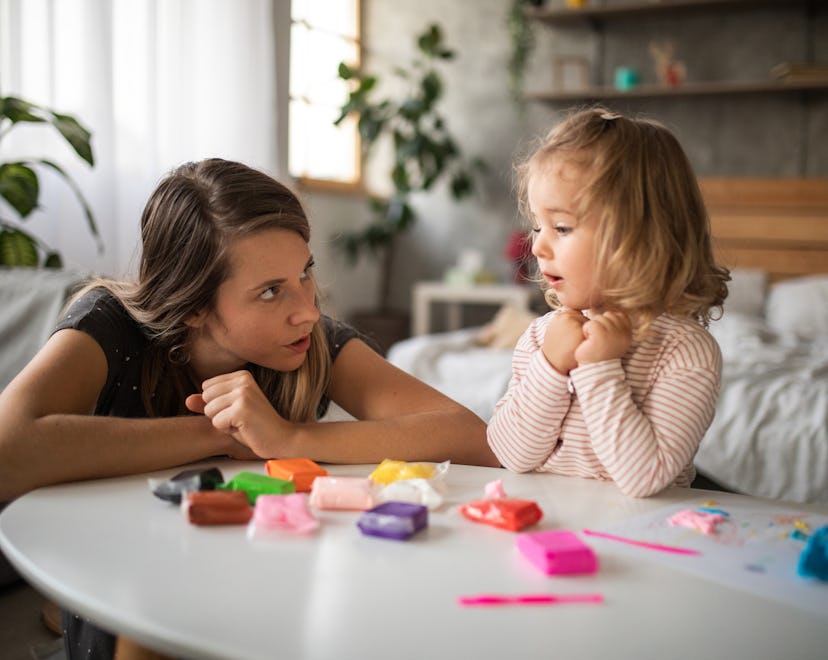Toddler

My Toddler Ate Play-Doh, What Happens Now? Don’t Freak Out
Every parent has been there.
Kids and toddlers eat weird stuff all the time — truly everything goes into their mouths — and parents have to figure out when they might have accidentally eaten something dangerous or toxic. One of the most common offenders is Play-Doh. It’s so much fun to play with, and such a classic sensory toy, you want to let your kid play with it. But, what should you do if your toddler eats Play-Doh, which honestly seems kind of inevitable? Is Play-Doh edible or is Play-Doh toxic and this is an emergency? Here’s what experts have to say about this very common rite of passage for many kids.
Is Play-Doh edible, or is Play-Doh toxic?
So, you probably know that Play-Doh is not for eating. Surely, you have told your children not to eat Play-Doh many, many times. But is it dangerous? Or can you eat Play-Doh? In most cases, a little modeling clay taste-test isn’t a huge cause for concern. “Eating Play-Doh is relatively harmless,” pediatrician Natasha Burgert, tells Romper. This is especially true for the stuff you buy from a store.
“In general, Play-Doh is considered to be minimally toxic IF it was bought from a store (commercially available). The commercially available forms of Play-Doh consist of clay,” Dr. Kelly Johnson-Arbor, medical toxicologist and co-medical director at National Capital Poison Center in Washington, DC., tells Romper. “Clay is not absorbed by the body, so it has minimal toxicity.”
My toddler ate Play-Doh. What do I do?
Our experts agree that if your kid ate Play-Doh, it is not necessarily an immediate cause for concern. You should consider, however:
- How much Play-Doh they ate
- What kind of Play-Doh your child ate, whether it is homemade or a certified non-toxic, store-bought brand
A few ingredients in commercially available Play-Doh could present an issue for certain individuals, but in general, the commonly-available brands of Play-Doh are non-toxic. “Some formulations do contain gluten and would be more problematic for children with Celiac Disease," says Dr. Burgert. If your child does have a gluten sensitivity, then check the label on your brand of modeling clay. “Some children (and adults) might be allergic to the various agents used to color the Play-Doh, so this could also be a concern,” says Johnson-Arbor. If your kid shows any signs of an allergic reaction after eating Play-Doh, then contact a medical professional right away.
What happens if your kid eats Play-Doh?
For the most part, parents can take a “wait and see” approach. “What we recommend from the poison control center is to observe the child and give food and drink as normal. If they tolerate that and are behaving normally, we know everything will be fine,” Dr. Diane P. Calello, Executive and Medical Director for the New Jersey Poison Information and Education System and Associate Professor of Emergency Medicine at Rutgers New Jersey Medical School, tells Romper.
Consider how much Play-Doh your toddler ate
“Large quantities would certainly upset a child's stomach and may cause some vomiting," says Burgert. Other signs of stomach distress could also occur. “Ingestion of larger amounts of commercial/store-bought Play-Doh would likely result in more minor symptoms of nausea, vomiting, abdominal pain, constipation, and/or diarrhea," says Dr. Johnson-Arbor. Again, if your kid is showing any symptoms that cause concern, call your pediatrician ASAP.
Be extra cautious with homemade Play-Doh
In addition, there are plenty of homemade play dough recipes that could contain potentially risky ingredients. “There are recipes available online for play dough, and these often contain high amounts of salt. Salt ingestion can be poisonous for humans and pets, and there is at least one report of a toddler who experienced life-threatening elevated sodium levels after eating homemade play dough,” says Johnson-Arbor. Raw flour is also very dangerous and can cause food poisoning.
Speaking of which, how do you prevent a toddler from chowing down on stuff that isn't food, anyway? Even the experts admit that this is a tough goal. “Preventing a toddler from eating non-food is tricky, especially because they put everything in their mouth! Keeping ‘edible’ non-food items, like Play-Doh and small toy pieces, within sight of the parent can be helpful,” says Calello. It's totally fine to hold off on these types of playthings until your child is past the “chew on anything and everything” phase. “If a child is unable to play without repetitively putting play dough in her mouth, then it's time to put the play dough away until she gets a bit older,” says Dr. Burgert. One day, your kid will be old enough to enjoy creating fun dough sculptures without trying to gnaw on them in the process.
Experts:
Natasha Burgert, M.D., FAAP, pediatrician in Overland Park, KS and writer at kckidsdoc.com
Kelly Johnson-Arbor, M.D., Co-Medical Director at the National Capital Poison Center, Medical Director of Hyperbaric Medicine in the Department of Plastic Surgery at MedStar Georgetown University Hospital
Diane P. Calello, M.D., FACMT, FAAP, FAACT, Executive and Medical Director for the New Jersey Poison Information and Education System and Associate Professor of Emergency Medicine at Rutgers New Jersey Medical School
This article was originally published on